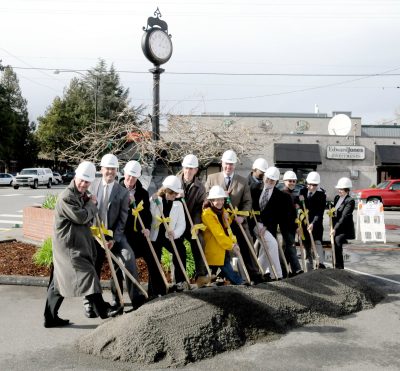 Building a successful museum also means helping build a successful community which, like building a museum, takes great patience. So our congratulations to the City of Snoqualmie for their courage of conviction: nine years of effort has secured enough funding to begin the first phase of historic downtown Snoqualmie’s infrastructure revitalization. New storm sewers, underground power, new sidewalks, and new street furniture including lamp standards, seating and even garbage cans. Railroad and logging motifs have been utilized by KPG Engineering, along with many features that emphasize the beautiful setting in which the community is situated. This first phase rebuilds Falls Avenue and the north side of Railroad Avenue, across the street from the Snoqualmie Depot. Phase two (which is still in design) will rebuild Railroad Avenue directly in front of the train station and expand downtown parking.
Building a successful museum also means helping build a successful community which, like building a museum, takes great patience. So our congratulations to the City of Snoqualmie for their courage of conviction: nine years of effort has secured enough funding to begin the first phase of historic downtown Snoqualmie’s infrastructure revitalization. New storm sewers, underground power, new sidewalks, and new street furniture including lamp standards, seating and even garbage cans. Railroad and logging motifs have been utilized by KPG Engineering, along with many features that emphasize the beautiful setting in which the community is situated. This first phase rebuilds Falls Avenue and the north side of Railroad Avenue, across the street from the Snoqualmie Depot. Phase two (which is still in design) will rebuild Railroad Avenue directly in front of the train station and expand downtown parking.
Speaking at the offical groundbreaking on 29 March 2010, Snoqualmie Mayor Matt Larson described the many hurdles that had to be overcome. Mayor Larson, the City Council, and the City Staff have certainly done that and then some.
The successful bidder was Sanders General Contracting from Issaquah who submitted the low bid of $2.3 million (and by just $17,000). Sanders is beginning work this week and expects to wrap up in October.
The largest single funder is the US Economic Development Administration, a unit of the US Department of Commerce who has provided a $1.4 million grant. The funding, which for Snoqualmie at times seemed elusive, was secured with the active involvement of Congressman Dave Reichert, King County Executive Dow Constantine and former Executive Ron Simms, and Puget Sound Regional Council. Not coincidentally, these same partners are helping the Northwest Railway Museum secure resources to develop public museum facilities.
Public works projects are never easy: disruption to everyday life will be significant over the next six months. This project will be different because Snoqualmie did their homework: staff and consultants met with affected businesses, property owners were invited to provide meaningful comment on the preliminary designs and input was actively incorporated into the final design, and construction activities are being actively managed to minimize impact on major events such as local athletic events, Day Out With Thomas, and Railroad Days.

